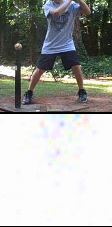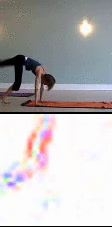This repository contains the code for our CVPR 2019 paper, Project Page:
AJ Piergiovanni and Michael S. Ryoo
"Representation Flow for Action Recognition"
in CVPR 2019
If you find the code useful for your research, please cite our paper:
@inproceedings{repflow2019,
title={Representation Flow for Action Recognition},
booktitle={Proceedings of the IEEE Conference on Computer Vision and Pattern Recognition},
author={AJ Piergiovanni and Michael S. Ryoo},
year={2019}
}
We introduce the representation flow layer, which can be found in rep_flow_layer.py. This layer iteratively estimates the flow, can be applied to CNN feature maps, and is fully learnable to maximize classification performance.
We include our pretrained models for HMDB and Kinetics in models/.
We tested our models on HMDB and Kinetics and provide the files and class labes used in data.
| Method | Kinetics-400 | HMDB | Runtime |
|---|---|---|---|
| 2D Two-Stream | 64.5 | 66.6 | 8546ms |
| TVNet (+RGB) | - | 71.0 | 785ms |
| (2+1)D Two-Stream | 75.4 | 78.7 | 8623ms |
| I3D Two-stream | 74.2 | 80.7 | 9354ms |
| (2+1)D + Rep-Flow | 75.5 | 77.1 | 622ms |
| (2+1)D + Flow-of-flow | 77.1 | 81.1 | 654ms |
Examples of representation flows for various actions. The representation flow is computed after the 3rd residual block and captures some sematic motion information. At this point, the representations are low dimensional (28x28).
Examples of representation flows for different channels for "clapping." Some channels capture the hand motion, while other channels focus on different features/motion patterns not present in this clip.
Our code has been tested on Ubuntu 14.04 and 16.04 using python 3.6, PyTorch version 0.4.1 with a Titan X GPU. Our data loading uses lintel to extract frames from the video.
-
Download the code
git clone https://github.com/piergiaj/representation-flow-cvpr19.git -
Pre-trained models are avialable here.
-
train_model.py contains the code to train and evaluate models.







